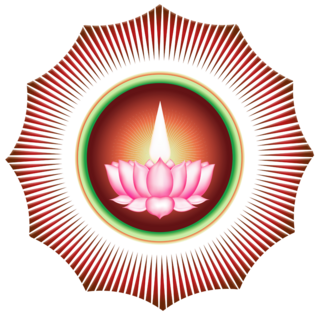
Lord Ayya Vaikundar, known to his followers as tenth avatar or incarnation of Lord Vishnu, also called as Sriman Narayana Vaikundaswamy or Narayana Pandaram, was a 19th-century social reformer and iconoclast who worked for the upliftment of downtrodden people in the Kingdom of Travancore. He is central to the Hindu denomination of Ayyavazhi, as per holy scripture.

Ayyavazhi is a henotheistic belief that originated in South India. It is cited as an independent monistic religion by several newspapers, government reports, journals, and academic researchers. In Indian censuses, however, the majority of its followers declare themselves as Hindus. Thus, Ayyavazhi is also considered a Hindu denomination. Officially (legally), it exists within Hinduism as a Hindu denomination.

Sampooranathevan is a mythical figure found in Ayyavazhi mythology. He was considered a powerful Deva of Deiva Loga. In Kali Yuga, He was born, and became known in history as Mudisoodum Perumal or Muthukutty.

Ayyavazhi mythology is the mythology of the South Indian religious faith known as Ayyavazhi, which is officially considered a Hindu sect. The main source of Ayyavazhi mythology is the Ayyavazhi scripture, Akilathirattu Ammanai, and its supplement, Arul Nool. The Akilathirattu Ammanai is a recitation by Mayon to his consort Lakshmi. It is divided into three sections: Early Avatars, incarnational events and post-incarnational events.

Dharma Yukam is the state of absolute bliss as per Ayyavazhi mythology. Dharma Yukam is described in the Akilam seventeen in Akilathirattu Ammanai. It is related to Dharmic moksha and to Abrahamic heaven.

Katuvai Sothanai, in Tamil means, Trial with Tiger. This is an important event in Ayyavazhi mythology tells us about the happenings that took place when Lord Vaikundar was thrown before a three-days-starving tiger.

The Santror are the seven boys who were brought to life by using the seven seeds from seven upper worlds, by Thirumal, to the Seven Virgins through their instrumentality, according to Ayyavazhi mythology. It also represents their descendants. According to Akilathirattu Ammanai, it additionally represents one who lives with Dignity.

The following outline is provided as an overview and topic guide to Ayyavazhi:

Ekam is the Sanskrit for "one, single, solitary", as a noun meaning "unity". In Hinduism, it refers to a concept of monism akin to that of Brahman in Advaita philosophy and Smarta theology.

Ayyavazhi and Hinduism are two belief systems in India. Although Ayyavazhi continues to officially exist within Hinduism and is considered by some observers to be a Hindu denomination, members of the religion claim that it is independent. The most notable distinction between Hinduism and Ayyavazhi is their different approaches to the concepts of good, evil and dharma.

Kali was the sixth fragment of the primordial manifestation of Kroni (evil) according to Akilathirattu, the source of Ayyavazhi mythology and the holy book of Ayyavazhi religion. Unlike other previous manifestations, Kali spread in this yugam as maya (illusion). Details of Kali were restated in Ayyavazhi Religion and he is the same Kali mentioned in Kalki Purana.

Akilam Two is the second among the seventeen parts of Akilathirattu Ammanai, the holy scripture of Ayyavazhi. This parts includes the whole of the Thretha Yukam and a few events of the Dwapara Yukam, such as creation of bodies of the god-heads and subjects of the yukam.

Akilam Five is the fifth section of Akilam, which is the primary scripture of Ayyavazhi. It narrates the cruel reign of Kaliyan, the death of two Santror and the subsequent curse given to Kali. It also hints about the start of the Kalineesan dynasty that tortured Vaikundar.

As Kalimayai captured the king of Thiruvitankur and began to rule over the people as their king, Thirumal came to Thiruvananthapuram according to Ayyavazhi mythology. This falls under Akilam five in Akilathirattu Ammanai.

Lord Vaikundar was the incarnation of Ekam according to Akilathirattu Ammanai, the religious text of Ayyavazhi and the source of Ayyavazhi mythology. As the Ekam is the supreme power in Ayyavazhi, Vaikundar was the supreme power incarnate.

Akilam six is the sixth section of Akilam, the primary holy scripture of Ayyavazhi. This section describes the transformation of the ruling authority of the universe from Sivan to Thirumal.

The Akilam nine is one of the sub-sections of Akilathirattu Ammanai the Primary scripture of Ayyavazhi. It describes the events taking place immediately before and at the time of incarnation of Vaikundar in the world.

The purpose of this chronology is to give a detailed account of Ayyavazhi from the beginning of the incarnational events of Vaikundar to the present time. Question marks on dates indicate approximate dates. A star (*) indicates the mentioning of that particular date in Akilam or Arul Nool. All dates but a few are found in the Tamil calendar and so doesn't coincide exactly with the months of the Gregorian calendar. The dates may span over any halves of the two consecutive months (Gregorian).

The Inclusiveness and exclusivity in Ayyavazhi is the inclusive and exclusive ideology of Ayyavazhi scriptures over other religions. The formula of inclusivism and exclusivism was applied in the religio-cultural universe of Ayyavazhi is one that is not found anywhere else in the world. Though there are separate verses towards inclusivism and exclusivism as central themes in Akilam, the mixture of both is unique. The inclusivistic theory of accepting the views of different religions for a certain period of time and from then onwards exclusivistically rejecting all of them by narrating that all the previous had lost their substances is a mythical as well as religious break-through.

The ethics of Ayyavazhi are found scattered throughout the primary scripture, Akilathirattu Ammanai. They are also integrated with the meta-narrative mythography. However, regarding ethics, Arul Nool is considered as an accumulation and prophecy of the core concepts found in Akilathirattu. In Akilathirattu, the ethical abstracts are pointed out as "told by God" at several places at different situations to lesser god-heads, devas, saints etc. when asked by them.



